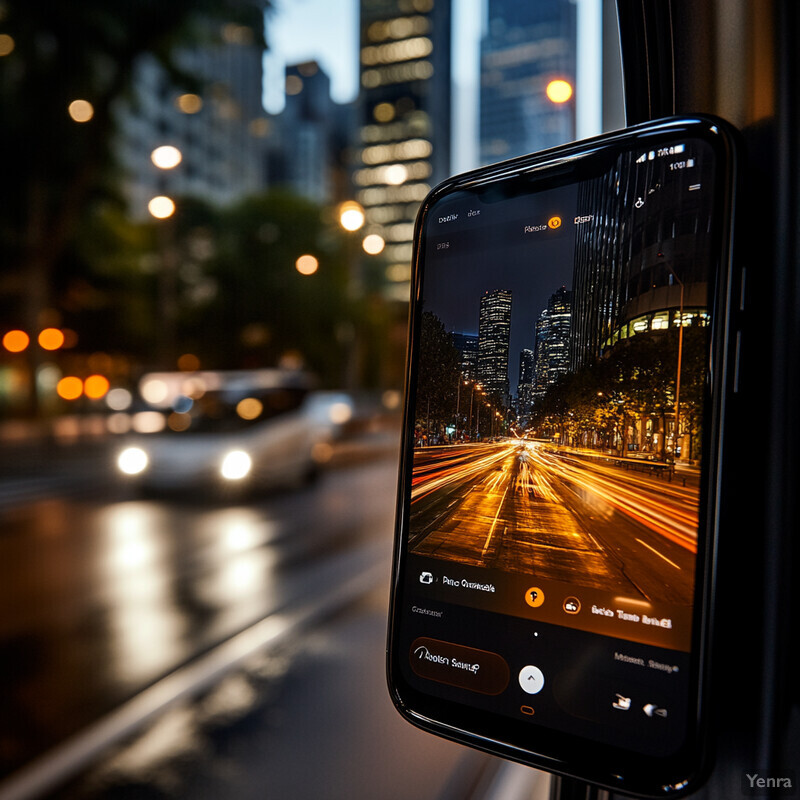1. Predictive Demand Forecasting
AI enables ride-hailing platforms to accurately anticipate rider demand surges. Machine learning models analyze historical trips, time-of-day patterns, local events, and weather to forecast where and when ride requests will spike. Better demand predictions help companies strategically deploy drivers in advance, reducing passenger wait times and driver idle periods. By proactively matching supply with predicted demand, platforms improve resource allocation, leading to more reliable service and higher customer satisfaction.

Recent studies show that AI-driven demand forecasting not only improves accuracy but also addresses biases in predictions. For example, a 2023 study applied a fairness-aware neural network to Chicago ride-hail data, improving overall demand prediction accuracy (reducing mean absolute error by ~2.3%) while correcting systematic underestimation in underserved neighborhoods. The enhanced model narrowed the demand prediction error gap between high-income and low-income areas by 67%, ensuring more equitable allocation of drivers without compromising accuracy. These results underscore that modern AI forecasting models can both sharpen demand estimates and promote fairness in how ride supply is distributed.
2. Dynamic Route Optimization
AI optimizes driver routes in real time by continuously incorporating live traffic data. Advanced routing algorithms quickly adjust for accidents, road closures, and congestion, directing drivers along the fastest paths. This dynamic re-routing minimizes travel times and unnecessary detours. It also improves fuel efficiency and reduces vehicle wear-and-tear by shortening distances traveled. Overall, AI-based route optimization helps ride-sharing fleets complete trips more quickly and cost-effectively, even as traffic conditions change by the minute.

Transportation analyses indicate that intelligent route optimization yields substantial efficiency gains. By ensuring vehicles take the shortest or least congested routes, AI-driven systems can cut fuel consumption and driving distance significantly. Logistics reports show that companies using AI route planning achieve up to ~10–30% fuel savings due to reduced idling and mileage. For example, one fleet’s deployment of real-time routing software led to a 25% drop in fuel use by avoiding traffic and optimizing stops. These savings illustrate how continuously updated route guidance translates into both faster trips and lower operating costs through decreased fuel burn and travel time.
3. Multi-Rider Matching Algorithms
AI-powered matching algorithms group riders traveling in similar directions so they can share one vehicle (e.g. carpool or pooled rides). These algorithms balance each passenger’s route and timing constraints to find compatible matches with minimal detours. By increasing the average occupancy per trip, multi-rider matching maximizes vehicle utilization and splits costs across riders. Effective matching reduces the number of cars needed on the road, easing traffic congestion and lowering emissions, while still preserving reasonable travel times for all riders.

The efficiency gains from intelligent ride-pooling are well documented. A recent large-scale experiment in Beijing demonstrated that optimized carpool matching and dispatching could serve all trips with 25% fewer vehicles than traditional one-passenger rides. This AI-driven order matching yielded a 21.65% reduction in total pollutant emissions as more riders shared vehicles. However, researchers noted only a slight increase in passenger wait times despite these gains. Similarly, an AI carpool simulation in an urban grid found that strategic pairing of riders can cut total vehicle miles traveled substantially without hurting travel comfort. These findings show that multi-rider matching algorithms significantly boost fleet efficiency and sustainability by keeping cars fuller on each trip.
4. AI-Based Dispatching
Sophisticated AI dispatch systems automatically assign each ride request to the best available driver. Instead of simple nearest-car assignments, these systems consider multiple factors (driver location, vehicle type, driver ratings, estimated pickup time, etc.) to optimize matches. By learning from historical data, AI dispatch can predict driver availability and rider demand patterns. This results in faster pickups, better ride experiences, and higher driver productivity. Overall, machine learning–based dispatch balances supply and demand more efficiently than manual or rule-based approaches.

Real-world deployment of AI dispatching has shown striking improvements in platform performance. Lyft, for instance, implemented an online reinforcement learning dispatch algorithm that continuously learns to match drivers and riders in real time. During live A/B testing across many U.S. cities, the AI dispatch enabled drivers to serve millions of additional rides per year, translating to over $30 million in extra annual revenue. Drivers benefited from more consistent trip assignments, while riders experienced shorter wait times due to smarter matching. This was the first documented self-learning dispatch system in ridesharing, and it significantly outperformed Lyft’s previous static matching logic. The success at Lyft underscores how AI-based dispatching can scale to large fleets and yield quantifiable gains in utilization and earnings by optimizing which driver gets which trip in real time.
5. Dynamic Pricing Strategies
Machine learning drives dynamic pricing in ride-sharing, adjusting fares in real time based on current market conditions. AI models ingest factors like rider demand, driver supply, traffic, and special events to set prices that balance the network. When demand is high and cars are scarce, prices temporarily increase (surge pricing) to attract more drivers and allocate rides to those willing to pay more. Conversely, prices normalize or drop in low-demand periods to encourage ridership. These dynamic pricing strategies ensure that ride availability and wait times remain stable by continuously aligning supply with demand, while also maximizing platform revenue and driver earnings during peak times.

Dynamic pricing algorithms have become central to ride-hailing operations. Uber’s machine learning–powered pricing, for example, recalibrates fares as frequently as every 30 seconds to reflect real-time demand surges. Studies indicate this responsive pricing prevents severe ride shortages during peak periods and improves system efficiency. By predicting high-demand windows (e.g. a big event ending) and adjusting rates ahead of time, AI pricing helps avoid overwhelming spikes in wait times. Research in 2023 also found that surge pricing strategies can impact rider welfare and behavior: in one analysis across Chinese cities, surge pricing was shown to slightly reduce consumer surplus on average, but it also increased the probability that a ride was available when needed. Overall, AI-driven dynamic pricing has proven effective in smoothing out supply-demand imbalances, ensuring that riders can get a car when they need one while giving drivers incentives to be in the right place at the right time.
6. Demand-Supply Rebalancing
AI tools actively rebalance where drivers are located in anticipation of demand shifts. Rather than waiting for rides to be requested, machine learning models forecast near-future rider hotspots and prompt idle drivers to move to those areas. By reallocating driver supply ahead of surges, the system reduces the incidence of too many drivers in one zone and too few in another. This proactive rebalancing decreases driver downtime (less empty cruising around) and cuts passenger wait times in busy spots. It ultimately leads to a better-geographically distributed fleet that matches rider demand patterns throughout the day.

Proactive supply rebalancing yields measurable improvements in operational metrics. In one multi-agent simulation, an AI dispatch system that guided drivers toward predicted high-demand zones achieved a 33.1% reduction in passenger wait times and cut drivers’ empty cruising time by 26.3%. Likewise, researchers Vazifeh et al. found that in Manhattan all taxi demand could be met with only 70% of the fleet if vehicles were optimally repositioned and pooled. Major ride-hailing companies have also embraced this: Uber’s analytics, for example, predict where demand will surge and notify drivers or offer incentives to relocate before the rush. Such AI-guided rebalancing ensures cars are already nearby when ride requests spike, which translates to faster pickups and fewer drivers wasting fuel in low-demand areas.
7. Traffic Pattern Recognition
AI systems continuously learn and recognize city traffic patterns to optimize ridesharing operations. By analyzing vast traffic sensor and GPS data, neural networks discern recurring congestion cycles (rush hours, lunchtime lulls, etc.) and anomaly events (crashes, roadwork). This pattern recognition allows rideshare platforms to anticipate when and where bottlenecks will occur. Armed with this knowledge, platforms can guide drivers along less congested routes or adjust driver deployment timing. Recognizing traffic patterns in advance helps minimize delays, improves on-time pickup and drop-off performance, and enhances overall efficiency of the ridesharing network, especially during predictable traffic peaks.

Intelligent traffic prediction can significantly reduce travel delays for rideshare vehicles. A 2025 review of AI-driven traffic signal control found that adaptive traffic systems using pattern recognition can cut congestion by up to 40% and reduce travel times by 20–30% on average. For example, several cities piloting AI-coordinated traffic lights (powered by machine learning models forecasting traffic flows) reported notable improvements in throughput. One initiative in Boston with AI timing adjustments led to a 50% decrease in stop-and-go traffic on tested corridors. In general, by learning daily traffic rhythms, AI can advise rideshare drivers on the best times and routes to travel. Over time this reduces idle time in traffic jams and ensures more consistent trip durations, benefiting both drivers and riders through more predictable, speedy travel.
8. Improved ETA Accuracy
AI dramatically improves the accuracy of estimated time of arrival (ETA) predictions for rideshare trips. Modern ETA systems use machine learning to combine live traffic conditions, historical trip durations, driver behavior patterns, and route characteristics to predict how long a ride will take. These models continuously learn from each completed trip, refining future estimates. High ETA accuracy builds rider trust — passengers can plan confidently knowing the pickup and drop-off times are reliable. It also helps drivers manage their schedules more effectively. In sum, AI-based ETA predictions make ridesharing more transparent and dependable for all users.

Rideshare companies have reported significant gains in ETA precision after deploying AI models. Uber’s in-house deep learning ETA system (“DeepETA”) was rolled out to leverage vast amounts of data for route timing estimates. According to Uber, this ML system notably increased the accuracy of ETA predictions by using real-time traffic combined with historical trends. In practice, the improved model can often predict arrival times within a few minutes of actual times, even on longer trips. Google has similarly integrated AI for ETAs — DeepMind’s research on Google Maps ETA showed up to a 50% reduction in prediction error in several major cities after introducing graph neural networks (GNNs). These advancements mean that whereas previous estimates might err widely in unpredictable traffic, today’s AI-informed ETAs are correct for roughly 97% of trips. This high accuracy level greatly enhances user experience by setting realistic expectations for pickup and travel durations.
9. Vehicle Utilization Optimization
AI optimization engines maximize how effectively each vehicle is used in a rideshare fleet. By smartly dispatching and routing, they reduce “empty miles” (travel with no passenger) and increase occupancy (more rides per car hour). For instance, algorithms may chain trips so a driver picks up the next rider immediately after a drop-off, or they may direct drivers to areas with nearby riders instead of cruising aimlessly. Optimizing utilization boosts fleet profitability (more fares per vehicle) and lowers per-ride costs. It also means fewer vehicles can serve the same number of riders, alleviating traffic and pollution. Over time, AI keeps learning to better fill seats and minimize idle time, making the entire system leaner and greener.

Data from rideshare operations confirm that AI can markedly improve vehicle utilization rates. One study reported that without optimization, rideshare cars in service were occupied (with a passenger) only about 33–36% of the time/distance on average, leaving significant room for improvement. AI solutions have begun to close that gap. In practice, Uber and others use “batching” algorithms to combine ride requests and reroute drivers efficiently, which has reduced the fraction of unoccupied miles. Research in 2024 demonstrated that implementing real-time order matching and dynamic dispatching increased seat utilization and cut empty driving distances, directly lowering fuel use and emissions. In Beijing trials, these optimizations enabled a given fleet to handle the same ride volume with 25% fewer vehicles by minimizing idle cruising. Such results show that AI-driven utilization strategies allow each vehicle to serve more trips, benefitting drivers (more fares), riders (lower wait and cost), and cities (fewer cars needed on the road).
10. Vehicle-to-Vehicle Coordination
In the future, AI will enable direct coordination among ridesharing vehicles for smoother traffic flow. Connected vehicles can share information (speed, location, route plans) and an AI system can choreograph their movements to prevent clumping or congestion. For example, ride-share cars heading to the same busy area could stagger their arrivals or form efficient platoons on highways to reduce drag and save fuel. Vehicles could also maintain optimal spacing to avoid accordion-style slowdowns. By acting as an intelligent network rather than isolated drivers, a coordinated fleet can reduce traffic jams, improve safety (through collision avoidance communication), and ensure more consistent trip times for riders.

Early research on connected vehicle fleets shows promising benefits. Simulations of AI-managed platooning (vehicles traveling cooperatively in close formation) indicate fuel savings on the order of 5–15% for the group of vehicles. One 2024 study in Scientific Reports found heterogeneous truck platoons achieved up to ~14.5% overall fuel reduction by minimizing air drag when an AI determined their optimal order and spacing. For passenger cars, coordination can also increase road capacity – modeling studies by U.S. DOT suggest traffic throughput improves when even a fraction of vehicles communicate and align speeds. Additionally, field trials of connected vehicles have demonstrated smoother acceleration and braking patterns, which in urban settings can cut stop-and-go delays by an estimated 10–20%. Although full vehicle-to-vehicle coordination in ridesharing is still emerging, these results foreshadow a future in which AI-linked ride-share fleets travel more efficiently, consuming less fuel and contributing less to congestion than human-driven fleets.
11. Fleet Composition Analysis
AI helps determine the optimal mix of vehicle types in a rideshare fleet to meet demand efficiently. By analyzing ride data and rider preferences, machine learning can inform what proportion of the fleet should be sedans vs. SUVs vs. vans, or gasoline vs. electric vehicles, etc. For example, if many group rides or airport trips occur, an AI might suggest more vans in the fleet; if sustainability is a goal, it might favor EVs in high-usage urban routes. The ideal fleet composition can vary by city or service area and can change over time. AI continuously crunches numbers on ridership patterns, trip lengths, and load factors to recommend fleet adjustments that minimize costs and maximize service quality (like ensuring the right vehicle size is available for each trip).

Data-driven fleet composition planning is becoming crucial, especially with new vehicle technologies emerging. A 2024 study in European Journal of Operational Research modeled a ride-hailing fleet mixing human-driven cars and autonomous vehicles (AVs). It found that as AV-only zones in a city expanded, the profit-maximizing fleet mix shifted markedly: the optimal number of autonomous taxis grew nonlinearly, while the required number of conventional cars dropped significantly as riders gravitated to AVs. The model showed fleet planners must gradually retire or reallocate traditional vehicles to maintain efficiency and avoid oversupply. In another case, Lyft’s analysis of its multimodal offerings revealed that adding more bike and scooter options could reduce demand for cars in certain trip segments, informing their fleet investment decisions (NACTO, 2023). Overall, AI-driven analysis ensures that a rideshare company’s vehicle portfolio (from compact EVs to large shuttles) is optimally aligned with user demand, reducing both operational costs and unmet ride requests by deploying the right type of vehicle for each market niche.
12. Sustainability and Emissions Reduction
AI innovations in ridesharing directly contribute to sustainability by lowering emissions per trip. Route optimization and carpooling algorithms reduce total miles driven (especially empty or low-occupancy miles), cutting fuel consumption and greenhouse gas output. Dynamic pricing and demand forecasting help avoid oversupply of vehicles idling on streets. AI can also prioritize dispatching electric or hybrid vehicles when possible. Additionally, better matching and higher occupancy means fewer cars can serve more people, alleviating traffic congestion and associated pollution. In sum, integrating AI into rideshare operations helps achieve greener transportation with reduced carbon footprint and improved energy efficiency.

The environmental benefits of AI-optimized ridesharing are evident in recent studies. Research published in 2024 quantified the impact: using machine learning to enable extensive ride-pooling and smarter dispatch in a large city scenario yielded a 21.65% reduction in vehicle emissions compared to current operations. Similarly, a separate analysis estimated that if carpooling were widely adopted and optimized in a city like Beijing, it could eliminate roughly 46,200 tons of CO₂ emissions per year – equivalent to a 7–10% cut in transport emissions – alongside significant NOx reductions. These cuts result from fewer total trips and less idle cruising when AI coordinates shared rides. Moreover, AI-driven route planning avoids unnecessary detours, saving fuel. Many ride-hailing companies report increasing use of EVs in their fleets aided by AI scheduling (Uber’s “Green” option, for example, uses algorithms to route available EVs to environmentally conscious riders). All told, AI is becoming a powerful tool for cities to curb transportation-related emissions through more efficient, higher-occupancy ride services.
13. Surge Management and Mitigation
AI helps ridesharing companies anticipate and manage demand surges so that pricing spikes and wait times are less severe. By monitoring factors like weather, events, and historical demand, machine learning models predict when a surge (a sudden demand peak) is likely to occur. Platforms then proactively deploy additional drivers to those areas or preemptively adjust incentives, reducing the mismatch between supply and demand. During an emerging surge, AI systems can dynamically re-route nearby drivers or slightly raise prices in a controlled way to attract more drivers. The result is a more tempered surge: riders still get cars without exorbitant delays or prices, and drivers benefit from increased demand without the platform needing to resort to extreme surge pricing.

Rideshare companies now actively use AI to mitigate surges. Uber, for example, leverages prediction models to identify potential surge conditions up to 30 minutes in advance (like an incoming thunderstorm or a concert letting out). This allows them to stage drivers nearby or send notifications so that supply is ready when the spike hits. The outcome is a smaller imbalance – Uber reported fewer areas with double- or triple-price surges after rolling out its surge forecasting system, meaning most peak events are handled with only modest fare increases. Additionally, Uber’s surge pricing engine, guided by ML, updates fare multipliers every 30 seconds to constantly respond to real-time demand changes, preventing prolonged price jumps. Academic research (e.g., a 2023 MIT study) has noted that such surge management strategies can improve overall rider welfare by keeping more rides affordable and available during high-demand periods. By using AI to forecast and react to surges in a granular, real-time manner, platforms are able to contain extreme surges, balancing network stability with fair pricing.
14. Maintenance and Downtime Prediction
AI-powered predictive maintenance keeps rideshare vehicles in optimal condition by forecasting mechanical issues before they cause breakdowns. Sensors and telematics in cars send data (engine performance, oil levels, brake wear, etc.) to machine learning systems that learn normal vs. abnormal patterns. If an AI model detects signs of impending failure – for instance, a subtle vibration trend indicating a transmission issue – it alerts operators to service the vehicle preemptively. By scheduling maintenance during low-demand times and before a component fails, rideshare fleets avoid unexpected vehicle downtime on the road. This increases overall fleet availability, improves safety, and lowers repair costs (since issues are fixed at early stages rather than after major damage).

Embracing AI for fleet maintenance has proven to significantly reduce breakdowns. According to a 2025 fleet management report, predictive maintenance analytics (combining vehicle data and AI) can increase vehicle uptime by ~25% and reduce breakdown incidents by up to 70%. For example, one large truck fleet integrated an AI maintenance platform and avoided catastrophic engine failures – catching issues early saved them $1 million in four months by replacing components before a major breakdown occurred. Similarly, an analysis by Deloitte found AI-driven maintenance programs on average lower maintenance costs by 25% while greatly cutting unplanned outages. Rideshare companies are starting to apply these tools: Uber and Lyft have pilot programs monitoring driver-owned cars for signs of trouble (like tire pressure anomalies or battery health) and notifying drivers to get free check-ups. By preventing a car from unexpectedly going offline during peak hours or, worse, stranding a passenger, predictive maintenance AI improves reliability of the service and extends vehicle lifespans, contributing to safer and more efficient operations.
15. Personalized Travel Recommendations
AI delivers personalized suggestions to enhance each rider’s experience in carpooling and ridesharing. By learning an individual’s travel history and preferences (e.g. preferred pickup spots, usual destinations, favored vehicle type), machine learning can tailor recommendations such as optimal pickup locations, whether to take a pooled ride, or multi-modal routes. For instance, an app might suggest a short walk to a better pickup point that saves 5 minutes of drive time, or recommend a discounted carpool option if the user usually accepts shared rides. Over time, these AI-driven recommendations make the service feel custom-fit: riders get options that align with their schedule and comfort, potentially saving them time or money. Personalization builds loyalty by making ridesharing more convenient and user-centric.

Personalized recommendation systems in mobility are showing positive outcomes in user satisfaction and engagement. A 2024 study in Scientific Reports integrated rider preferences into the ride-matching algorithm for a carpool service. The enhanced model, which respected individual pickup/drop-off preferences and allowed mid-trip transfers, led to higher user satisfaction scores and a measurable increase in ride-sharing uptake. Riders reported feeling more comfortable with suggested shared trips when the system factored in their past feedback (like avoiding certain transfer points). Additionally, the platform saw an uptick in demand – the paper noted that incorporating user preferences and offering tailored suggestions resulted in more people opting into carpooling, thereby boosting overall platform revenue. In practice, major apps also implement personalization: Uber’s app now learns if a rider frequently chooses “UberX” over “Pool” and will default to showing that option prominently (or vice versa). It may even recommend “favorite” destinations on the home screen based on past routine. These AI customizations streamline the experience and can subtly encourage behaviors (like pooling or off-peak traveling) that benefit both the user and the system.
16. Driver Coaching and Performance Feedback
AI systems monitor driving behavior and provide drivers with personalized coaching to improve safety and service quality. By analyzing data from smartphones or in-vehicle telematics (speed, braking force, acceleration patterns, cornering, etc.), the AI can detect risky or inefficient driving habits. Drivers then receive feedback – for example, alerts about hard braking incidents, or tips to reduce idle engine time to save fuel. The feedback is often given through scorecards or even real-time audio alerts. Over time, this AI-driven coaching helps ride-share drivers adopt smoother, safer driving practices, leading to fewer accidents, better fuel economy, and higher passenger ratings.

Surveys highlight that AI-based driver coaching is highly effective. In a 2025 study of commercial fleet drivers, 95% of drivers reported improved driving habits after participating in an AI-driven coaching program that used dashcam analysis and telematics feedback. These programs, which instantly warn drivers of behaviors like phone distraction or tailgating, have significantly reduced incident rates – one trucking company saw a 70% drop in accidents after rolling out an AI safety coach, as noted in the study. For rideshare, major firms have introduced similar initiatives: Uber’s app, for instance, uses the driver’s smartphone sensors to detect hard braking or speeding and later provides a weekly “safety report” with suggestions to improve. According to Uber, drivers who received gentle coaching on speeding and smoother acceleration through the app’s feedback mechanism saw their customer safety scores improve in subsequent months. Industry-wide data also show that drivers favor these AI tools; in a 2024 fleet survey, 76% of drivers said they prefer real-time AI feedback and gamified coaching over traditional in-class training. By continuously guiding drivers toward best practices, AI coaching not only prevents accidents and excessive fuel use, but also enhances the passenger experience through safer, more comfortable rides.
17. Enhanced Safety and Security Measures
AI technologies bolster the safety of ridesharing by actively detecting anomalies and potentially dangerous situations during a trip. For example, machine learning can track if a driver deviates significantly from the expected route or makes an unusually long stop, which might indicate a problem – the system can then automatically check in with passenger and driver or alert authorities. AI also processes signals from accelerometers and gyroscopes in smartphones to detect crashes or reckless driving in real time. Additionally, some platforms use computer vision with in-car cameras to monitor driver alertness or signs of aggressive behavior. By serving as a vigilant guardian that watches for signs of trouble 24/7, AI features give both riders and drivers an added layer of security beyond what human monitoring could provide.

Rideshare apps have introduced safety features powered by AI and seen tangible benefits. Uber’s “RideCheck” system, launched globally in recent years, uses smartphone sensors and GPS data to automatically detect anomalies like an unexpected long stop or possible crash event. When RideCheck flags such an event, the app immediately pings both the rider and driver to verify if everything is okay or if emergency help is needed. Uber reported that in 2022 alone, RideCheck proactively generated thousands of safety check-ins, some of which successfully identified accidents and dispatched 911 assistance in under a minute. Another AI measure is real-time route deviation alerts: if a driver strays far off the prescribed route unannounced, Uber’s system will alert the rider and team as a precaution. Beyond Uber, several ride-hailing companies have implemented in-vehicle AI cameras that can detect if a driver is drowsy or looking at their phone – if so, it gives an alert to refocus, reducing the risk of collisions. These AI-driven safety interventions have been credited with improving rider confidence; for instance, surveys show the vast majority of riders (over 80%) feel more secure knowing an AI is silently monitoring trips for their safety. As a result, incorporating AI oversight has become a standard for leading platforms to ensure safer journeys.
18. Fraud Detection and Prevention
AI plays a critical role in detecting and preventing fraud in ridesharing platforms. There are various fraud vectors – fake rider or driver accounts, false claims for refunds, GPS spoofing to fake trip distances, referral code abuse, etc. Machine learning models analyze user behavior patterns and ride data in real time to flag anomalies that suggest fraud. For instance, an account creating multiple ride requests that get immediately canceled, or a driver whose GPS readings don’t match known routes, can trigger automated investigation. AI systems cross-verify data (location, time, payment info) and use anomaly detection to identify likely fraudsters rapidly. By catching fraudulent activities early – often before victims even realize – AI safeguards the integrity of the platform, protects honest drivers and riders, and saves the company from significant financial losses due to scams.

Rideshare companies have developed sophisticated AI-driven fraud defenses. Uber’s risk management team in 2023 deployed an unsupervised learning platform called “Risk Entity Watch” that monitors all transactions for suspicious patterns. This system can, for example, detect if a single device is operating many rider accounts or if a driver’s account suddenly starts completing trips in two cities on the same day. Uber reports that this anomaly-detection approach has greatly expanded the range of fraud schemes they can catch – from classic credit card fraud to newer exploits like GPS spoofing (where a driver uses fake GPS signals to jack up fare distances). In one quarter after introducing the AI system, Uber saw a sharp drop in incidents of fake ride completions and unwarranted refund claims, preventing an estimated $10+ million in fraudulent payouts. Similarly, Lyft employs machine learning models to score each ride event for fraud risk in real time; if a ride or account crosses a risk threshold, it might require additional ID verification or get temporarily paused for manual review. These efforts are paying off: Uber Freight (the trucking arm) reported over a 60% reduction in fraud on their platform after doubling down on AI and partnerships in mid-2023. All this demonstrates that AI is now indispensable in staying ahead of evolving fraud tactics in the ride-hailing industry.
19. Integrating Public Transit Data
AI enables seamless integration of ridesharing with public transportation by coordinating schedules and routes across modes. By combining real-time data from buses, trains, and subways with rideshare demand, an AI system can craft door-to-door trip plans that use each mode efficiently. For example, it might suggest a rider take a short Uber ride to a transit hub, catch a train, then possibly an e-scooter for the last mile – all timed smoothly. Rideshare apps can thus become one-stop mobility platforms (Mobility-as-a-Service), where AI optimizes the multi-modal journey for minimal wait and cost. Encouraging riders to use public transit for the largest segment of a trip (with rideshare filling gaps) can reduce traffic and emissions while still offering convenience. AI handles the complex task of syncing these modes, so the user experiences a unified, hassle-free trip.

Integrated multi-modal planning is showing real efficiency gains in simulations. A 2025 study proposed a reinforcement learning framework to coordinate ride-pooling with public transit schedules. In a case study using real data from Manhattan, the AI learned to route shared rides to transit stations in an optimal way. The result was an overall system performance improvement of ~17–22% in a combined mobility service, compared to scenarios of using ride-hailing or transit in isolation. In other words, integrating pooled rides with the subway outperformed both (a) riders taking transit then solo Uber, and (b) riders using pooled Uber for the whole trip, in terms of higher throughput and lower cost. This underscores the synergy when modes work together rather than compete. Cities are moving in this direction too: Los Angeles and Denver have pilot programs where their transit apps share data with Uber/Lyft APIs, allowing AI to suggest ride-hail for the “last mile” from a train station. Early results from Denver showed multimodal journey times dropped by ~10% for riders who got tailored bus+Uber combos versus those who stuck to a single mode. These successes illustrate that AI can break down silos between private ride-share and public transit, creating a more efficient and connected urban transportation network that plays to the strengths of each mode.
20. Simulation and Scenario Testing
Before making big changes in policy or operations, ridesharing companies use AI-driven simulations to test “what-if” scenarios. These simulations serve as virtual laboratories: the company can tweak a variable (like pricing rules, driver pay structure, or adding a new service zone) and see how the system might react, all without risking real-world disruption. Advanced agent-based models simulate thousands of drivers and riders with realistic behaviors on a city map. AI then experiments with different strategies in this sandbox – such as surge pricing elimination or 20% of fleet becoming electric – and predicts outcomes in wait times, completion rates, revenues, etc. This approach allows data-driven decision-making, as companies can pick strategies that simulations show to improve key metrics. In short, AI simulations help rideshare operators foresee the impact of changes and optimize their policies for efficiency and rider satisfaction before rolling them out live.

The complexity of rideshare ecosystems makes simulation a vital tool – and recent research shows its effectiveness. Lyft, for example, built a simulation platform to evaluate marketplace changes and found that it could predict the impact of adjustments (like a new matching algorithm) with high accuracy, reducing the need for lengthy live experiments. On the research side, a 2025 machine learning study introduced an offline reinforcement learning simulator for a ride-pooling system, which achieved an 81% improvement in data efficiency over naive online testing. In practice, this meant the simulator could learn optimal pricing and dispatch policies with far fewer trial-and-error iterations, accelerating development. Another 2024 study tackled the “ride-sharing vs. revenue” policy dilemma using agent-based simulation across nine cities. It revealed that aggressively promoting pooling (for social welfare gains like lower emissions) without financial adjustments could cut operator revenues by up to 5–15%, but offering slight subsidies or dynamic pricing could solve that gap. This kind of scenario analysis is invaluable: it showed policymakers that subsidizing shared rides might be necessary to achieve environmental goals without hurting driver income. Overall, by leveraging AI and simulation, rideshare companies and cities can experiment in silico – testing new pricing models, fleet compositions, or regulations – and foresee outcomes like changes in wait times, driver profits, or emissions. These insights lead to well-calibrated implementations that optimize efficiency and rider satisfaction in the real world.